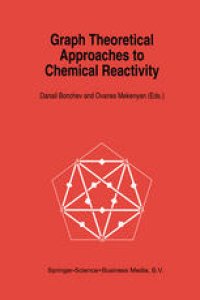
Ebook: Graph Theoretical Approaches to Chemical Reactivity
- Tags: Physical Chemistry, Discrete Mathematics in Computer Science
- Series: Understanding Chemical Reactivity 9
- Year: 1994
- Publisher: Springer Netherlands
- Edition: 1
- Language: English
- pdf
The progress in computer technology during the last 10-15 years has enabled the performance of ever more precise quantum mechanical calculations related to structure and interactions of chemical compounds. However, the qualitative models relating electronic structure to molecular geometry have not progressed at the same pace. There is a continuing need in chemistry for simple concepts and qualitatively clear pictures that are also quantitatively comparable to ab initio quantum chemical calculations. Topological methods and, more specifically, graph theory as a fixed-point topology, provide in principle a chance to fill this gap. With its more than 100 years of applications to chemistry, graph theory has proven to be of vital importance as the most natural language of chemistry. The explosive development of chemical graph theory during the last 20 years has increasingly overlapped with quantum chemistry. Besides contributing to the solution of various problems in theoretical chemistry, this development indicates that topology is an underlying principle that explains the success of quantum mechanics and goes beyond it, thus promising to bear more fruit in the future.
This is the first book to concentrate on elucidating chemical reactivity from the viewpoint of molecular topology. Describing the most fundamental structural patterns in molecules, topology and graph theory are regarded to be the ideal tools for exploring the relationships between the structure and the properties of chemical compounds. A team of internationally recognized experts from seven countries present a variety of graph-theoretical and topological approaches to chemical reactivity. The specific topics covered include among others, the latest developments in the interplay between graph theory and molecular orbital theory, three dimensional molecular shapes and their changes, isomerization reactions in organic and inorganic chemistry, topological indices and their application to structure-reactivity relationships and mechanistic studies. Useful topology-based reactivity rules and more general principles controlling topology changes in chemical reactions are also presented.
For researchers, teachers and students in all areas of chemistry.
This is the first book to concentrate on elucidating chemical reactivity from the viewpoint of molecular topology. Describing the most fundamental structural patterns in molecules, topology and graph theory are regarded to be the ideal tools for exploring the relationships between the structure and the properties of chemical compounds. A team of internationally recognized experts from seven countries present a variety of graph-theoretical and topological approaches to chemical reactivity. The specific topics covered include among others, the latest developments in the interplay between graph theory and molecular orbital theory, three dimensional molecular shapes and their changes, isomerization reactions in organic and inorganic chemistry, topological indices and their application to structure-reactivity relationships and mechanistic studies. Useful topology-based reactivity rules and more general principles controlling topology changes in chemical reactions are also presented.
For researchers, teachers and students in all areas of chemistry.
Content:
Front Matter....Pages i-xi
Introduction to Graph Theory....Pages 1-36
The Interplay Between Graph Theory and Molecular Orbital Theory....Pages 37-72
Topological Control of Molecular Orbital Theory: A Comparison of µ2-Scaled H?ckel Theory and Restricted Hartree-Fock Theory for Boranes and Carboranes....Pages 73-108
Polyhedral Dynamics....Pages 109-135
Reaction Graphs....Pages 137-180
Discrete Representations of Three-Dimensional Molecular Bodies and Their Shape Changes in Chemical Reactions....Pages 181-208
The Invariance of Molecular Topology in Chemical Reactions....Pages 209-220
Topological Indices and Chemical Reactivity....Pages 221-239
Graph-Theoretical Models of Complex Reaction Mechanisms and their Elementary Steps....Pages 241-275
Back Matter....Pages 277-283
This is the first book to concentrate on elucidating chemical reactivity from the viewpoint of molecular topology. Describing the most fundamental structural patterns in molecules, topology and graph theory are regarded to be the ideal tools for exploring the relationships between the structure and the properties of chemical compounds. A team of internationally recognized experts from seven countries present a variety of graph-theoretical and topological approaches to chemical reactivity. The specific topics covered include among others, the latest developments in the interplay between graph theory and molecular orbital theory, three dimensional molecular shapes and their changes, isomerization reactions in organic and inorganic chemistry, topological indices and their application to structure-reactivity relationships and mechanistic studies. Useful topology-based reactivity rules and more general principles controlling topology changes in chemical reactions are also presented.
For researchers, teachers and students in all areas of chemistry.
Content:
Front Matter....Pages i-xi
Introduction to Graph Theory....Pages 1-36
The Interplay Between Graph Theory and Molecular Orbital Theory....Pages 37-72
Topological Control of Molecular Orbital Theory: A Comparison of µ2-Scaled H?ckel Theory and Restricted Hartree-Fock Theory for Boranes and Carboranes....Pages 73-108
Polyhedral Dynamics....Pages 109-135
Reaction Graphs....Pages 137-180
Discrete Representations of Three-Dimensional Molecular Bodies and Their Shape Changes in Chemical Reactions....Pages 181-208
The Invariance of Molecular Topology in Chemical Reactions....Pages 209-220
Topological Indices and Chemical Reactivity....Pages 221-239
Graph-Theoretical Models of Complex Reaction Mechanisms and their Elementary Steps....Pages 241-275
Back Matter....Pages 277-283
....